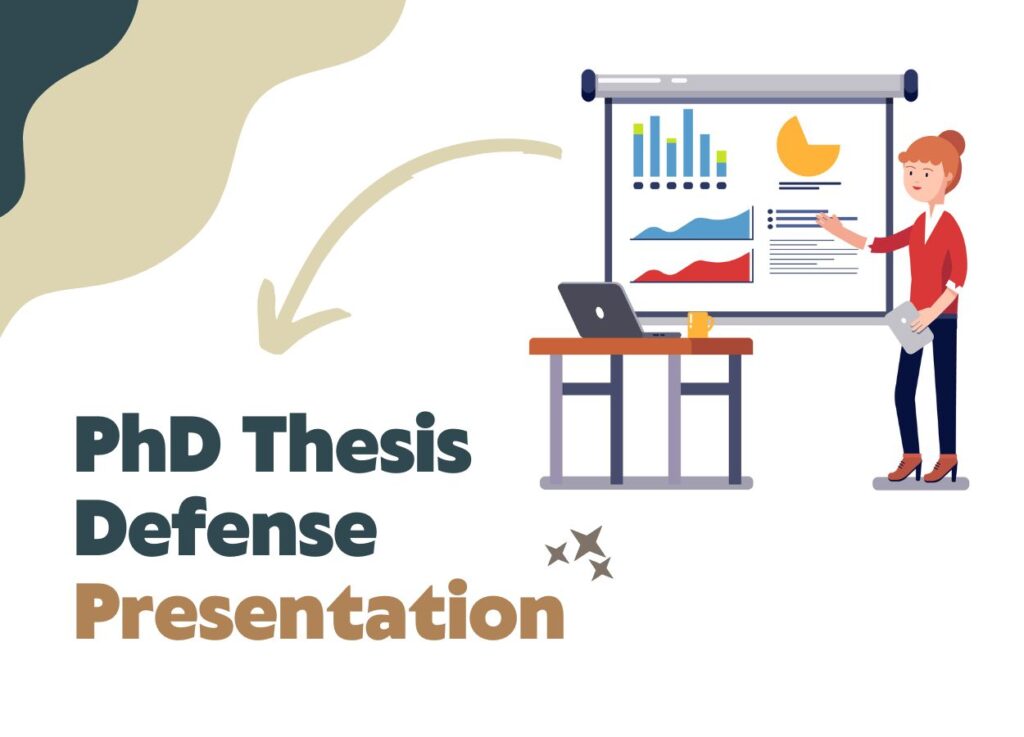“PhD thesis defense presentation is prepared at the terminal of the degree to show the research work in the form of a PowerPoint Presentation. Students often fail miserably because they lack knowledge of presentation. Here are some tips to help them.”
Firstly, congratulate yourself. You have gone through all the pains, problems, and stress and that’s come to over. PhD is a difficult task, indeed. So have done fantastic work, If you are on the way to preparing your PhD defense presentation.
But my friend, the game is yet not over. You are now at the critical phase and now chances of errors are less. For that 1-hour discussion session, everything should be nearly perfect. From your presentation (with a number of slides) to how you will present.
You have to care about every single point starting from the number of slides, text, visuals, content quantity, and audience attention to the final conclusion. Everything must be in your control.
But unfortunately, it’s not a story for many. Students fail to give a good presentation, even though their work is great. And advised for re-viva. There are so many reasons for that. Three major points that fail a presentation are– presentation preparation, delivery and audience engagement.
What is a thesis defense?
The thesis defense is a process to justify your work with logical arguments with the referees. To know more read this article: Defending a PhD thesis like a boss!- an in-depth Guide.
In this article, I will give you 10 tips– proven, practical and actionable to give an amazing PhD thesis defense presentation. Stay tuned.
10 Tips for PhD Thesis Defense Presentation
1. Plan your presentation
PhD is all about planning– I mean, proper planning. So, you also have to plan for your presentation. Remember, you are at the last stage of getting the honor hence things must be nearly perfect and in your favor.
Make a rough outline of the points you will discuss in the presentation. Don’t forget to include major and important points. Moreover, give a strong introduction by keeping in mind that the audience is totally unaware of the topic.
Plan how much text you will use, and the thing about how the evaluator understands and interprets it. Accordingly, prepare your answers. Last, constrain the content in the number of slides recommended by the university.
Organize each point in a logical sequence and around your research topic only. Don’t give too much information.
2. Text to the visual ratio
Your success in the presentation depends on the attention and retention time on each slide. So you should have to balance every slide with texts and visuals. Texts should create curiosity which visuals satisfy and vice versa.
If your text-to-visual ratio is good, people will give more attention to your talk. However, I strongly recommend not using visuals on every slide. Use when and only it’s needed. After all, it’s a professional demonstration.
Don’t fill too much text in a slide and the visuals too. Don’t use every image you captured for your results. Use it in the form of one master image, table or chart to show results. Visuals are great for the eyes– the next point explains.
3. Use visuals
Imagine there are two types of information on the slide, one written in the form of long text and another in the form of visuals, charts, bars, images and tables, where do you focus? What attracts you more?
Obviously the second one!
Summarize your ideas, findings and results in the form of a chart, bar, image, table or anything that looks good. Visual helps your audience to engage and at the same time makes things easier to understand.
Nonetheless, do care about the ratio. Don’t use too many visuals on every slide.
4. Number of slides
If I ask you, what is the main goal to present your work? To engage an audience and deliver your work. But your research work would only be delivered if people will engage with it. There is a psychology behind numbers.
People don’t want more if it isn’t understandable. So if at the beginning of the presentation, they know that you have 50 to 60 slides, they naturally feel bored. Try using fewer slides. It creates curiosity. Give more time to explain your point.
Ideally, I recommend using 20 to 22 slides.
5. Practice to present
Practice makes everyone perfect.
What is more important– Giving more time to prepare the presentation or on how to deliver it? As I aforementioned, planning is the key to success even though you know everything about your research.
Give more time for preparation. Know which slide contains which point, what is more important, and which slide would take more time. Where to stay and explain, and where to go in a rush. You should have to know everything in order to control the entire session.
Practice becoming more comfortable with the content you prepared. Record or observe your delivery scheme. Adjust your tone, speech, pace and body language accordingly.
6. Engage people
People will only admire your work only if they engage. So first, follow the previous point– focus on how you will deliver your presentation. In addition, create curiosity, ask questions, and give some amazing information timely, encourage them to ask questions.
Also, engage people psychologically— keep a small smile, look confident, and see in their eyes while explaining your point. Dress decently to attract. Use different hand gestures and styles to gain their focus.
7. Language
You should have a strong grip on the language. If not, work on it, at least for your presentation. Do use transition words to control the flow and engage people. Use emotions with each transition. Use can use words like— furthermore, in addition, however, unfortunately, fortunately, nonetheless, etc.
Do learn which transition work to use when, why and how, and accordingly use the exact emotion to use it. This increases the overall attention on your presentation.
8. Strong conclusion
All’s well that ends well.
Give a strong conclusion. To end your presentation, give a quick summary– verbally and conclude your point or research in a sentence that best describes it. Create a positive impact by explaining how it would help society or mankind.
Show a strong emotion to depict the conclusion. Your conclusion should satisfy the audience and inspire them to learn more and ask questions.
9. Be prepared for discussion
Now once your session ends, it’s now open for discussion. Encourage or confidently tell the audience to ask their queries. Answer each question to the point and logically. Explain concepts rather than points.
Admire them for asking questions, and say thank you for their involvement. In case you don’t know the answer, accept it and convince them that you will find the answer.
10. Technical considerations
- The first slide should have your research title, name, guide name and all other credentials necessary.
- The title should be large enough to read and bold.
- Every slide should have titles and each must be readable enough.
- Every slide should have a slide number.
- The fond style for presentation is “Times New Roman”.
- There are no guidelines for font size but every font should be readable enough.
- Visuals are clear enough and have high quality.
- Use bold, underline, and highlight when needed.
- Use at least 1.5 spacing between lines.
- The presentation file must be in ‘.ppt’.
Wrapping up
Our students have amazing experience delivering their presentations because we have a huge experience on how to prepare it, deliver it and play with the audience’s mind. Our students prepare well, follow our guidelines and know what questions the referee or audience will ask.
The reason is their preparation and control over their presentation. If you want to make your presentation amazing you can contact us. I will personally guide you in a 1-hour class. Nonetheless, by keeping these points in mind you can make a difference with your ppt.
I hope this information and tips will help you to deliver an amazing PhD thesis defense presentation.




